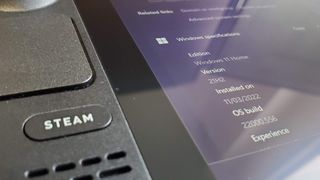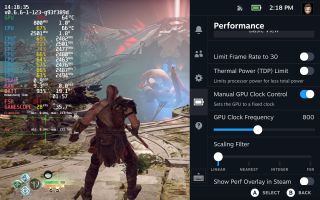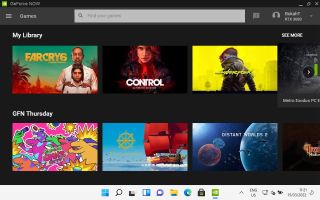PC Gamer is supported by its audience. When you buy through links on our site, we may earn an affiliate commission. Learn more
By published
I hadn’t quite realised just how integral SteamOS was to my feelings about Valve’s handheld.
There are reasons you’d want to stick Windows onto Valve’s Steam Deck. Obviously contrarianism is one. Morbid, geeky curiosity, another. Then there’s a desire to play Destiny 2, Fortnite, or a bunch of Microsoft games that have been nixed from the original Linux-based SteamOS 3.0 installation. But having made the jump into Windows 11 myself this past weekend, I need to tell you none of those reasons are good enough to rob the Steam Deck of its soul.
I’m not talking about the lack of full driver support for Microsoft’s operating systems, or the weird little bugs that crop up as you go, I’m not even talking about the way gaming performance is down on Windows vs. SteamOS either. I mean, it definitely is with such immature, buggy drivers, but my problem is that that booting into Windows on the Deck feels nothing less than completely deflating, like you’re utterly missing the point of the device in your hands.
And you are.
I mean, it works. Mostly. Right now Valve is only offering an AMD-made driver that will get you GPU and Wi-Fi support, but no audio, and actually worse gaming performance to boot. But strap on some Bluetooth earware and the sound works fine, boot up Skyrim for the millionth time and that will still hit the 60Hz limit of the screen without fuss, and the controls will work fine and let you game as long as the battery lasts. Which, admittedly, isn’t long.
But Windows is not made for small screen life, and nor is it designed for a dedicated gaming device, either. It’s a multi-function operating system made for the Swiss Army Knife that is a modern PC. On something with such a pure focus on handheld gaming as the Steam Deck it’s a mostly awkward experience.
I had been excited to get Windows onto the Deck, however. I haven’t really got on with Linux since I stopped using an ultra lightweight distribution on my Netbook back in 2009, and have periodically dallied with different distros on my gaming PC—yes, even SteamOS. But I’ve always found Windows a more comfortable environment for my gaming pleasures. And the instant Valve gave the okay for a Windows installation by releasing the Aerith drivers I wanted to get it onto my Deck.
The modest thrill of actually getting Windows 11 up and running on the Steam Deck quickly evaporated
But it almost already is. You only need to use the Rufus ISO mounting software to build a bootable USB drive, and that gives you a one-click method for bypassing those requirements. No modified ISO, no extra hoops to jump through, just an easy install process.
It took no time to get Windows 11 on the Deck and in working order; the Wi-Fi drivers self-installed automatically, and it was soon updated and ready for use.
Though the modest thrill of actually getting Windows 11 up and running on the Steam Deck, admittedly with some trackpad oddities, quickly evaporated. Then I was just left with a soulless handheld gaming PC like all the others that have failed to excite so far.
And if you were hoping Big Picture Mode might be the saviour of Windows on the Deck… I’m afraid you’re going to be as disappointed as I was. It won’t even render at the Deck’s native 16:10 resolution.
Valve’s aggressive pricing of the Steam Deck is a massive part of its potential as a device, but SteamOS itself is the thing that will make or break it as an ecosystem. That’s what separates it from the crowd, and is what’s going to make every other handheld gaming PC worth getting your hands on.
The Deck version of SteamOS 3.0 has these simple quality of life features that makes it a great handheld operating system. For one, you never need to leave your game. Checking battery life, power profile, or even the time requires you to alt-tab out of a Windows game. And that’s tough to do on a device without a keyboard.
On the Steam Deck you just have to press the ellipsis button and it’s all there without removing you from your gaming pleasure.
But there are some benefits to having Microsoft’s operating system. Docking is far easier, and I was able to get a full 100Hz refresh rate at my standard monitor’s 3440×1440 native resolution, where SteamOS stuck resolutely to 60Hz and a 16:9 1440p res. There is also still seemingly some plug order etiquette going on, where a HDMI cable can only be plugged into the Deck’s dock after that dock has been plugged into the Deck itself.
You will also get access to all the games that have nixed Steam Deck support because they can’t trust the security of Linux with their anti-cheat software, games such as Destiny 2 and Fortnite. 
There is a way to make Windows a perfect partner for the Steam Deck, however, and that’s to dual boot. Unfortunately we’re still a little way off that eventuality—Windows won’t install as the secondary OS to one already in place, at least not easily, and Valve hasn’t released a version of SteamOS that you can dual boot with.
That will give you the best of both worlds, and build on the incredible versatility already baked into the Deck. You’re even going to be able to dump Windows onto an SD card and boot from that. 
I tried squeezing SteamOS 3.0 onto the OneXplayer Mini and that almost worked. Well, I got a cursor and a brief flash of the Steam Deck logo. Then nothing.
When Valve does release a final, open version of SteamOS 3.0, however, that’s going to open things up for all the existing handheld gaming PCs already on the market, and pave the way for even more. Hell, it could even make a bunch of low-spec laptops look interesting. I’m certainly slapping it on my Razer Blade Stealth 13.
I have to say, this wasn’t what I expected. When I first turned on my Steam Deck it was the hardware that most impressed me, while the oft-patched software felt unfinished. But after spending some time with an entirely unsuitable Windows installation I’ve seen the light, and you’re doing the Deck a disservice ditching its bespoke OS.
Dave has been gaming since the days of Zaxxon and Lady Bug on the Colecovision, and code books for the Commodore Vic 20 (Death Race 2000!). He built his first gaming PC at the tender age of 16, and finally finished bug-fixing the Cyrix-based system around a year later. When he dropped it out of the window. He first started writing for Official PlayStation Magazine and Xbox World many decades ago, then moved onto PC Format full-time, then PC Gamer, TechRadar, and T3 among others. Now he’s back, writing about the nightmarish graphics card market, CPUs with more cores than sense, gaming laptops hotter than the sun, and SSDs more capacious than a Cybertruck.
Sign up to get the best content of the week, and great gaming deals, as picked by the editors.
Thank you for signing up to PC Gamer. You will receive a verification email shortly.
There was a problem. Please refresh the page and try again.
PC Gamer is part of Future US Inc, an international media group and leading digital publisher. Visit our corporate site.
© Future US, Inc. Full 7th Floor, 130 West 42nd Street, New York, NY 10036.











